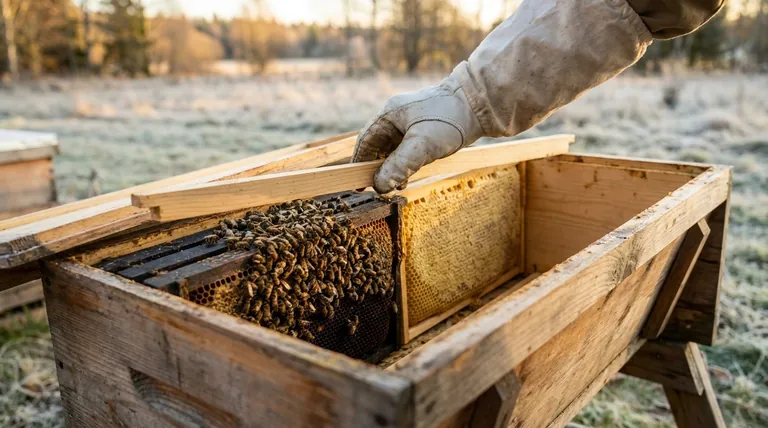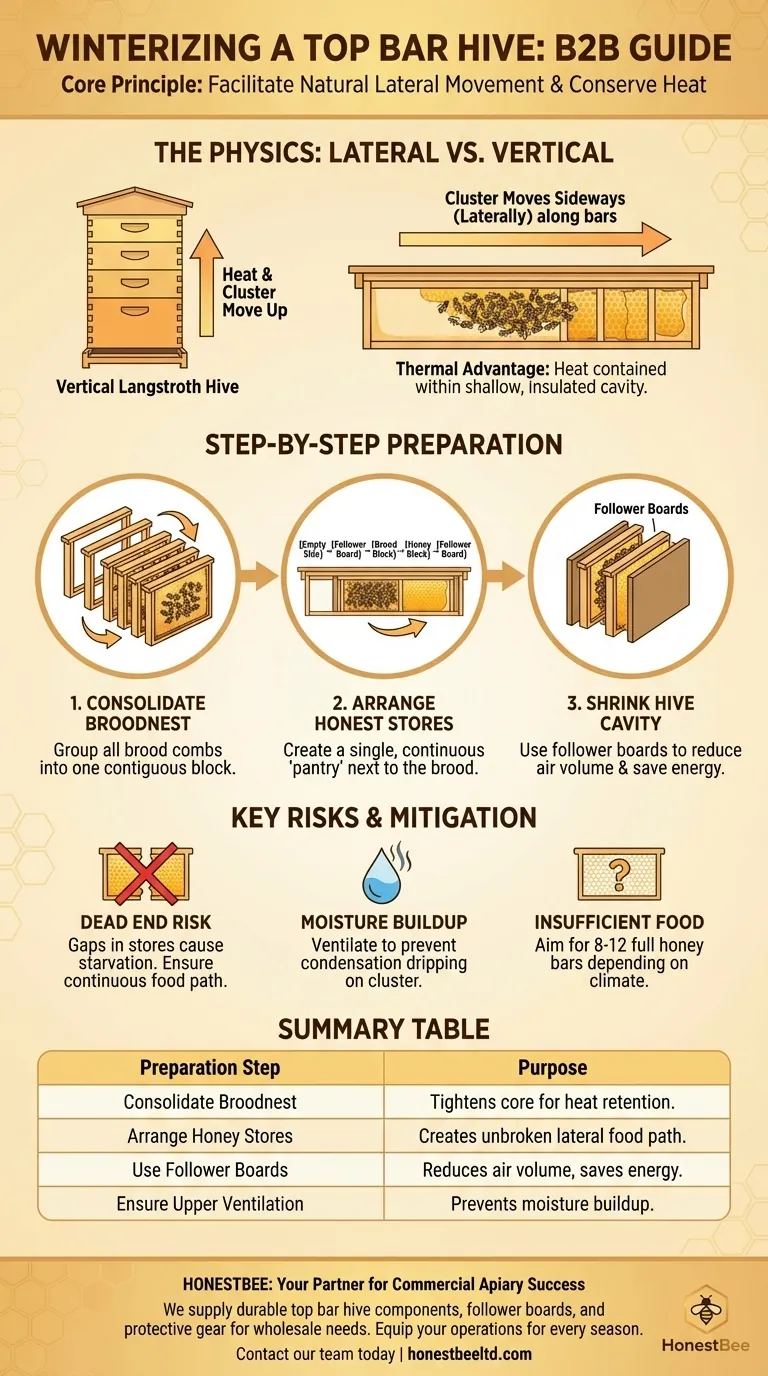Preparing a top bar hive for winter involves strategically reconfiguring the hive's interior to match the colony's shrinking size and natural behavior. This process centers on two key actions: consolidating all honey stores to one side of the broodnest and using follower boards to reduce the total interior volume the bees must keep warm.
The core principle of winterizing a top bar hive is to facilitate the colony's natural lateral movement. Unlike a vertical Langstroth hive where the cluster moves up, your colony will move horizontally along the bars, consuming one comb of honey at a time. Your goal is to create a compact space with an uninterrupted path of food.

The Physics of a Horizontal Hive in Winter
A top bar hive's design presents unique challenges and advantages for overwintering. Understanding the "why" behind your preparation is crucial for success.
The Logic of Lateral Movement
In a vertical hive, the winter cluster consumes its stores and slowly moves upward into fresh honey boxes. In a long, horizontal hive, the cluster moves sideways. They will start on their brood combs and, as winter progresses, move along the top bars into the adjacent honey-filled combs.
Your preparation must create a clear, unbroken path for this movement. Any empty combs or gaps in the honey stores can act as a dead end, causing the cluster to starve even when food is just a few inches away.
The Thermal Advantage
The long, low-profile design of a top bar hive offers a significant thermal benefit. As bees generate heat, it rises. In a tall, vertical hive, this heat can easily escape into empty upper boxes, forcing the bees to expend more energy.
In a top bar hive, the heat is contained within the relatively shallow cavity and is insulated by the solid wooden top bars and roof. This creates a more energy-efficient space for the bees to maintain the critical temperature of their winter cluster.
Step-by-Step Winter Preparation
Follow these steps in late fall, after the final honey harvest and as the weather begins to cool.
Step 1: Consolidate the Broodnest
Inspect your hive and locate all the combs containing brood. Move these combs so they are all side-by-side in one contiguous block.
Remove any empty or partially drawn combs that are in between brood combs. This consolidation tightens the core of the colony.
Step 2: Arrange the Honey Stores
Next, take all of your full honey combs and place them directly next to the broodnest, on one side. This creates a large, single "pantry" for the bees. The colony will naturally move from the brood area into this honey block as winter progresses.
The order should be: [Empty Side of Hive] -> [Follower Board] -> [Brood Combs] -> [Honey Combs] -> [Follower Board].
Step 3: Shrink the Hive Cavity
Use your follower boards—solid partitions shaped like a comb—to shrink the usable space inside the hive. Place one board firmly against the last honey comb and another against the outer brood comb (if you are positioning the cluster in the middle of the hive).
This reduces the volume of air the bees need to heat, saving immense energy. The bees should have just enough space for their cluster and their food stores, with no wasted, empty space to manage.
Understanding the Key Risks
Proper configuration is vital because mistakes can be fatal for the colony.
The "Dead End" Risk
The single greatest risk in a top bar hive is creating a "dead end." If the bees move through their honey and encounter an empty comb or a follower board with more honey on the other side, they cannot cross the cold gap.
The cluster will starve on that final comb. This is why arranging the honey in one continuous block is non-negotiable.
Moisture and Ventilation
A well-insulated hive can trap moisture released by the bees' respiration and metabolism. This moisture can condense on cold surfaces, drip down onto the cluster, and chill the bees.
Ensure your hive has adequate upper ventilation. A small, screened opening or even slightly offset top bars can allow this moist air to escape without creating a cold draft.
Insufficient Food Stores
The horizontal design does not change the fundamental need for food. A colony requires a substantial amount of honey to generate heat and survive winter. While needs vary by climate and colony size, aiming for 8-12 full, heavy bars of honey is a safe target.
Making the Right Choice for Your Goal
Your specific actions should be guided by your climate and your colony's strength.
- If your primary focus is surviving a harsh winter: Prioritize maximizing honey stores and shrinking the hive cavity as much as possible. Consider adding external insulation, like a foam board, on top of the hive roof.
- If your primary focus is a mild climate: The principles of consolidation still apply, but the total volume of honey required may be less. The risk of starvation is lower, but moisture control remains important.
- If you are unsure about your honey stores: Always err on the side of caution. Leave more honey than you think they need; you can always harvest it in the spring if it goes unused.
By configuring your hive to support the colony's natural winter instincts, you give them the best possible chance of survival.
Summary Table:
| Key Winter Preparation Step | Purpose |
|---|---|
| Consolidate Broodnest | Tightens the colony's core for efficient heat retention. |
| Arrange Honey Stores in One Block | Creates an unbroken food path for the cluster's lateral movement. |
| Use Follower Boards to Shrink Space | Reduces the volume of air the bees need to heat, saving energy. |
| Ensure Adequate Upper Ventilation | Prevents moisture buildup that can chill and kill the colony. |
Ensure your apiary is fully equipped for a successful season.
Preparing your hives for winter is just one part of successful beekeeping. HONESTBEE supplies commercial apiaries and beekeeping equipment distributors with the durable, high-quality supplies needed for every season. From top bar hive components like follower boards to essential protective gear, our wholesale-focused operations ensure you get the reliable equipment your business depends on.
Contact our team today to discuss your wholesale needs and keep your colonies thriving.
Visual Guide

Related Products
- HONESTBEE Professional Long Handled Hive Tool with Precision Cutting Blade
- Long Langstroth Style Horizontal Top Bar Hive for Wholesale
- Top Bar Beehive for Beekeeping Wholesales Kenya Top Bar Hive
- HONESTBEE Professional Multi-Functional Hive Tool with Ergonomic Wood Handle
- HONESTBEE Advanced Ergonomic Stainless Steel Hive Tool for Beekeeping
People Also Ask
- What are some common uses of a hive tool? Essential Multi-Purpose Tool for Every Beekeeper
- What is a hive tool used for in beekeeping? Your Essential Guide to Hive Management
- What are the features of a regular hive tool? The Essential Multi-Tool for Every Beekeeper
- Why do hive tools have a hole? Unlock the Secret to Efficient Beekeeping
- What is the hive tool used for? The Essential Multi-Tool for Every Beekeeper



















